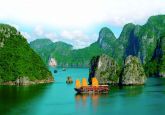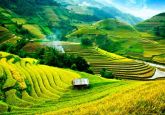Vietnam background information
Vietnam, officially the Socialist Republic of Vietnam, is the easternmost country on the Indochina Peninsula in Southeast Asia. It has an estimated 94.6 million inhabitants as of 2016, it is the world's 14th-most-populous country, and the ninth-most-populous Asian country. Vietnam is bordered by China to the north, Laos to the northwest, Cambodia to the southwest, Thailand across the Gulf of Thailand to the southwest, and the Philippines, Malaysia and Indonesia across the South China Sea to the east and southeast. Its capital city has been Hanoi since the reunification of North and South Vietnam in 1976, with Ho Chi Minh firmly immersed is this part of its recent history city as well.
Vietnam History
The first civilisations of Vietnam emerged about 5,000 years ago in the Red River Valley of Northern Vietnam. These tribes developed independently until 207 B.C., and then the region was conquered by a Chinese lord, who established a kingdom called Nam Viet.
In 111 B.C. Nam Viet became part of Imperial China until A.D. 939 when a Vietnamese commander named Ngo Quyen organized a revolt, which culminated in a Vietnamese victory at the Battle of Bach Dang River. The Chinese were driven out and an independent state was formed. Successive Vietnamese imperial dynasties flourished and named the country Dai Viet. The nation expanded geographically and politically into Southeast Asia. By the middle of the 16th century, Dai Viet was divided into two rival kingdoms, the Trinh dynasty in the north and the Nguyen dynasty in the south.
In 1802 the Trinh were defeated by a Nguyen lord, with the help of the French and the country was renamed Vietnam. However the increasing influence and power of France in the region led to them taking over the country in 1890.
The Japanese had control of the country for a short time during World War II and when they were defeated in 1945, Ho Chi Minh, the leader of the Vietnamese Communist Party, declared the country an independent nation. The French attempted to reclaim Vietnam but local communist forces, called Viet Minh fought back, eventually expelling the French in 1954. Thereafter, Vietnam was divided politically into two rival states, North and South Vietnam. Conflict between the two sides continued with Russia and China getting involved and there was heavy intervention from the United States on the side of South Vietnam from 1965 to 1973. The war ended with a North Vietnamese victory in 1975.
Vietnam was then unified under a Marxist-Leninist government but remained impoverished and politically isolated. In 1986, the government initiated a series of economic and political reforms which began Vietnam's path towards integration into the world economy. By 2000, it had established diplomatic relations with all nations. Since 2000, Vietnam's economic growth rate has been among the highest in the world. Vietnam remains one of the world's four remaining one-party socialist states.
Vietnam Geography
Vietnam is located on the eastern Indochina Peninsula between the latitudes 8° and 24°N, and the longitudes 102° and 110°E. It is about the size of Germany. The country can be split into five main regions as follows:-
- The mountainous region of the Far North, where you’ll find the country’s highest mountain, Fansipan, in the Sapa area of Lao Cai. Other highlights include Ha Giang, and the magnificent Ban Gioc waterfall on the Chinese border in the north-east.
- North Vietnam, the home of the capital, Hanoi and the Red River Delta region. Hanoi itself has a multitude of cultural attractions with some fantastic French colonial architecture to admire. Venture further afield and Halong Bay, Ninh Binh and Tam Dao are all worthwhile pit-stops.
- Central Vietnam, with such highlights as Danang’s beachside resorts, Hue where the ancient emperors of the Nguyen dynasty resided, and Hoi An was a busy trading port between the 15th and 19th
- The Annamite mountain range of the Central highlands can be considered as Vietnam’s backbone and holds some gems too such as, Dalat and Lake Lak.
- Finally, South Vietnam, home of Ho Chi Minh City (formerly Saigon) and also where the vast and mighty Mekhong River flows out into the South China Sea.
The combined length of the country's land boundaries is 4,639 km, and its coastline is 3,444 km long. At its narrowest point in the central Vietnam, the country is as little as 50 kilometres across, though it widens to around 600 kilometres in the north. Vietnam's land is mostly hilly and densely forested, with level land covering no more than 20%. Mountains account for 40% of the country's land area, and tropical forests cover around 40%.
The northern part of the country consists mostly of highlands and the Red River Delta. Fansipan, located in Lao Cai Province, is the highest mountain in Vietnam, standing 3,143 m high. Southern Vietnam is divided into coastal lowlands, the mountains of the Annamite Range, and extensive forests. The soil in much of southern Vietnam is relatively poor in nutrients.
Vietnam Culture
Vietnamese are a group-orientated society used to living and working in close proximity to each other. The Red River Delta region, with almost 19 million inhabitants, is one of the most densely populated areas on earth.
Before over 1,000 years of Chinese rule between 111 B.C. and 939 A.D., old Vietnamese society was organized along hierarchical feudal lines. Tribal chiefs were usually large landowners and controlled the serfs. After the Chinese conquered the land, they brought with them elements of their culture, specifically Confucian and Tao values. In recent centuries, the influence of Western cultures, most notably France and the United States, have become evident in Vietnam.
The traditional focuses of Vietnamese culture are humanity and harmony; family and community values are highly regarded. Vietnam reveres a number of key cultural symbols, such as the Vietnamese dragon, which is derived from crocodile and snake imagery; Vietnam's National Father, Lac Long Quan, is depicted as a holy dragon. The lac – a holy bird representing Vietnam's National Mother, Au Co – is another prominent symbol, while turtle and horse images are also revered.
The age-old tradition of respect for the elderly is reflected in the leadership. Traditions, especially in the countryside and mountains, don’t really apply to modern city life but show the cultural resemblance of the Vietnamese to the Khmer and Indonesian peoples and accentuate the non-Chinese side of their culture. However, Chinese cultural influence is quite pervasive and this is evident in architecture, religion, music, literature, poetry and theatre.
In the modern era, the cultural life of Vietnam has been deeply influenced by government-controlled media and cultural programs. For many decades, foreign cultural influences – especially those of Western origin – were shunned. However, since the 1990s, Vietnam has seen a greater exposure to Southeast Asian, European and American culture and media.

















READER COMMENTS (No Comment)
No comments for this articls!